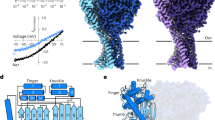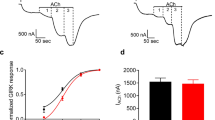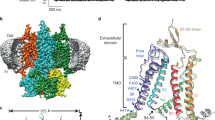Abstract
γ-aminobutyric acid (GABA) mediates fast inhibitory neurotransmission by activating anion-selective ligand-gated ion channels. Although electrophysiological studies indicate that GABA may activate cation-selective ligand-gated ion channels in some cell types, such a channel has never been characterized at the molecular level. Here we show that GABA mediates enteric muscle contraction in the nematode Caenorhabditis elegans via the EXP-1 receptor, a cation-selective ligand-gated ion channel. The EXP-1 protein resembles ionotropic GABA receptor subunits in almost all domains. In the pore-forming domain of EXP-1, however, the residues that confer anion selectivity are exchanged for those that specify cation selectivity. When expressed in Xenopus laevis oocytes, EXP-1 forms a GABA receptor that is permeable to cations and not anions. We conclude that some of the excitatory functions assigned to GABA are mediated by cation channels rather than by anion channels.
This is a preview of subscription content, access via your institution
Access options
Subscribe to this journal
Receive 12 print issues and online access
$209.00 per year
only $17.42 per issue
Buy this article
- Purchase on Springer Link
- Instant access to full article PDF
Prices may be subject to local taxes which are calculated during checkout






Similar content being viewed by others
Accession codes
References
Bormann, J., Hamill, O.P. & Sakmann, B. Mechanism of anion permeation through channels gated by glycine and gamma-aminobutyric acid in mouse cultured spinal neurones. J. Physiol. 385, 243–286 (1987).
Cherubini, E., Gaiarsa, J.L. & Ben-Ari, Y. GABA: an excitatory transmitter in early postnatal life. Trends Neurosci. 14, 515–519 (1991).
Ben-Ari, Y. et al. GABAergic mechanisms in the CA3 hippocampal region during early postnatal life. Prog. Brain Res. 83, 313–321 (1990).
Kaila, K., Lamsa, K., Smirnov, S., Taira, T. & Voipio, J. Long-lasting GABA-mediated depolarization evoked by high-frequency stimulation in pyramidal neurons of rat hippocampal slice is attributable to a network-driven, bicarbonate-dependent K+ transient. J. Neurosci. 17, 7662–7672 (1997).
Staley, K.J., Soldo, B.L. & Proctor, W.R. Ionic mechanisms of neuronal excitation by inhibitory GABAA receptors. Science 269, 977–981 (1995).
Perkins, K.L. Cl− accumulation does not account for the depolarizing phase of the synaptic GABA response in hippocampal pyramidal cells. J. Neurophysiol. 82, 768–777 (1999).
Goldmakher, G.V. & Moss, R.L. A subset of periglomerular neurons in the rat accessory olfactory bulb may be excited by GABA through a Na+-dependent mechanism. Brain Res. 871, 7–15 (2000).
Swensen, A.M. et al. GABA and responses to GABA in the stomatogastric ganglion of the crab Cancer borealis. J. Exp. Biol. 203, 2075–2092 (2000).
Norekian, T.P. GABAergic excitatory synapses and electrical coupling sustain prolonged discharges in the prey capture neural network of Clione limacina. J. Neurosci. 19, 1863–1875 (1999).
Yarowsky, P.J. & Carpenter, D.O. Receptors for gamma-aminobutyric acid (GABA) on Aplysia neurons. Brain Res. 144, 75–94 (1978).
McIntire, S.L., Jorgensen, E., Kaplan, J. & Horvitz, H.R. The GABAergic nervous system of Caenorhabditis elegans. Nature 364, 337–341 (1993).
Bamber, B.A., Beg, A.A., Twyman, R.E. & Jorgensen, E.M. The Caenorhabditis elegans unc-49 locus encodes multiple subunits of a heteromultimeric GABA receptor. J. Neurosci. 19, 5348–5359 (1999).
White, J.G., Southgate, E., Thomson, J.N. & Brenner, S. Factors that determine connectivity in the nervous system of Caenorhabditis elegans. Cold Spring Harb. Symp. Quant. Biol. 48, 633–640 (1983).
Jin, Y., Jorgensen, E., Hartwieg, E. & Horvitz, H.R. The Caenorhabditis elegans gene unc-25 encodes glutamic acid decarboxylase and is required for synaptic transmission but not synaptic development. J. Neurosci. 19, 539–548 (1999).
Thomas, J.H. Genetic analysis of defecation in Caenorhabditis elegans. Genetics 124, 855–872 (1990).
McIntire, S.L., Jorgensen, E. & Horvitz, H.R. Genes required for GABA function in Caenorhabditis elegans. Nature 364, 334–337 (1993).
Betz, H. Ligand-gated ion channels in the brain: the amino acid receptor superfamily. Neuron 5, 383–392 (1990).
Reiner, D.J. & Thomas, J.H. Reversal of a muscle response to GABA during C. elegans male development. J. Neurosci. 15, 6094–6102 (1995).
Karlin, A. & Akabas, M.H. Toward a structural basis for the function of nicotinic acetylcholine receptors and their cousins. Neuron 15, 1231–1244 (1995).
Langosch, D., Thomas, L. & Betz, H. Conserved quaternary structure of ligand-gated ion channels: the postsynaptic glycine receptor is a pentamer. Proc. Natl. Acad. Sci. USA 85, 7394–7398 (1988).
Boileau, A.J., Newell, J.G. & Czajkowski, C. GABAA receptor beta 2 Tyr97 and Leu99 line the GABA-binding site. Insights into mechanisms of agonist and antagonist actions. J. Biol. Chem. 277, 2931–2937 (2002).
Wagner, D.A. & Czajkowski, C. Structure and dynamics of the GABA binding pocket: A narrowing cleft that constricts during activation. J. Neurosci. 21, 67–74 (2001).
Leonard, R.J., Labarca, C.G., Charnet, P., Davidson, N. & Lester, H.A. Evidence that the M2 membrane-spanning region lines the ion channel pore of the nicotinic receptor. Science 242, 1578–1581 (1988).
Akabas, M.H., Kaufmann, C., Archdeacon, P. & Karlin, A. Identification of acetylcholine receptor channel-lining residues in the entire M2 segment of the alpha subunit. Neuron 13, 919–927 (1994).
Barnard, E.A. The molecular biology of GABAA receptors and their structural determinants. Adv. Biochem. Psychopharmacol. 48, 1–16 (1995).
Galzi, J.L. et al. Mutations in the channel domain of a neuronal nicotinic receptor convert ion selectivity from cationic to anionic. Nature 359, 500–505 (1992).
Weber, W. Ion currents of Xenopus laevis oocytes: state of the art. Biochim. Biophys. Acta. 1421, 213–233 (1999).
Sieghart, W. Structure and pharmacology of gamma-aminobutyric acid A receptor subtypes. Pharmacol. Rev. 47, 181–234 (1995).
Wang, T.L., Hackam, A.S., Guggino, W.B. & Cutting, G.R. A single amino acid in gamma-aminobutyric acid rho 1 receptors affects competitive and noncompetitive components of picrotoxin inhibition. Proc. Natl. Acad. Sci. USA 92, 11751–11755 (1995).
Zhang, D., Pan, Z.H., Zhang, X., Brideau, A.D. & Lipton, S.A. Cloning of a gamma-aminobutyric acid type C receptor subunit in rat retina with a methionine residue critical for picrotoxinin channel block. Proc. Natl. Acad. Sci. USA 92, 11756–11760 (1995).
Gurley, D., Amin, J., Ross, P.C., Weiss, D.S. & White, G. Point mutations in the M2 region of the alpha, beta, or gamma subunit of the GABAA channel that abolish block by picrotoxin. Receptors Channels 3, 13–20 (1995).
Varanda, W.A. et al. The acetylcholine receptor of the neuromuscular junction recognizes mecamylamine as a noncompetitive antagonist. Mol. Pharmacol. 28, 128–137 (1985).
Zhang, W., Han, X.Y., Wong, S.M. & Takeuchi, H. Pharmacologic characteristics of excitatory gamma-amino-butyric acid (GABA) receptors in a snail neuron. Gen. Pharmacol. 28, 45–53 (1997).
Imoto, K. et al. Rings of negatively charged amino acids determine the acetylcholine receptor channel conductance. Nature 335, 645–648 (1988).
Lester, H.A. The permeation pathway of neurotransmitter-gated ion channels. Annu. Rev. Biophys. Biomol. Struct. 21, 267–292 (1992).
Wilson, G.G. & Karlin, A. The location of the gate in the acetylcholine receptor channel. Neuron 20, 1269–1281 (1998).
Xu, M. & Akabas, M.H. Identification of channel-lining residues in the M2 membrane-spanning segment of the GABAA receptor alpha1 subunit. J. Gen. Physiol. 107, 195–205 (1996).
Keramidas, A., Moorhouse, A.J., Pierce, K.D., Schofield, P.R. & Barry, P.H. Cation-selective mutations in the M2 domain of the inhibitory glycine receptor channel reveal determinants of ion-charge selectivity. J. Gen. Physiol. 119, 393–410 (2002).
Gunthorpe, M.J. & Lummis, S.C. Conversion of the ion selectivity of the 5-HT(3a) receptor from cationic to anionic reveals a conserved feature of the ligand-gated ion channel superfamily. J. Biol. Chem. 276, 10977–10983 (2001).
Keramidas, A., Moorhouse, A.J., French, C.R., Schofield, P.R. & Barry, P.H. M2 pore mutations convert the glycine receptor channel from being anion- to cation-selective. Biophys. J. 79, 247–259 (2000).
Langosch, D. et al. Decreased agonist affinity and chloride conductance of mutant glycine receptors associated with human hereditary hyperekplexia. Embo J. 13, 4223–4228 (1994).
Moorhouse, A.J., Keramidas, A., Zaykin, A., Schofield, P.R. & Barry, P.H. Single channel analysis of conductance and rectification in cation-selective, mutant glycine receptor channels. J. Gen. Physiol. 119, 411–425 (2002).
Ortells, M.O. & Lunt, G.G. Evolutionary history of the ligand-gated ion-channel superfamily of receptors. Trends Neurosci. 18, 121–127 (1995).
Mello, C.C., Kramer, J.M., Stinchcomb, D. & Ambros, V. Efficient gene transfer in C. elegans: extrachromosomal maintenance and integration of transforming sequences. Embo J. 10, 3959–3970 (1991).
Clark, S.G., Lu, X. & Horvitz, H.R. The Caenorhabditis elegans locus lin-15, a negative regulator of a tyrosine kinase signaling pathway, encodes two different proteins. Genetics 137, 987–997 (1994).
Sigel, E., Baur, R., Kellenberger, S. & Malherbe, P. Point mutations affecting antagonist affinity and agonist dependent gating of GABAA receptor channels. Embo J. 11, 2017–2023 (1992).
Boileau, A.J., Evers, A.R., Davis, A.F. & Czajkowski, C. Mapping the agonist binding site of the GABAA receptor: evidence for a beta-strand. J. Neurosci. 19, 4847–4854 (1999).
Westh-Hansen, S.E. et al. Decreased agonist sensitivity of human GABAA receptors by an amino acid variant, isoleucine to valine, in the alpha1 subunit. Eur. J. Pharmacol. 329, 253–257 (1997).
Westh-Hansen, S.E. et al. Arginine residue 120 of the human GABAA receptor alpha 1, subunit is essential for GABA binding and chloride ion current gating. Neuroreport 10, 2417–2421 (1999).
Amin, J. & Weiss, D.S. GABAA receptor needs two homologous domains of the beta-subunit for activation by GABA but not by pentobarbital. Nature 366, 565–569 (1993).
Acknowledgements
We thank K. Schuske for cosmid injections and helpful advice, and M.W. Davis for full-length cDNA predictions, technical assistance and critical readings of this manuscript. The alleles n2570, n2641 and n2676 were isolated in the laboratory of B. Horvitz. We thank J. Thomas for the sa6 allele, discussions and encouragement. A. Coulson and the Sanger Center provided cosmid clones. We thank M. Hollmann for the pSGEM expression vector. We thank the Olivera, McIntosh and Yoshikami labs for X. laevis oocyte isolation and Z. Altun for cell identification. This work was supported by a National Institutes of Health Grant (E.M.J.). A.A.B. is supported by an Epilepsy Foundation of America predoctoral fellowship and a University of Utah predoctoral fellowship.
Author information
Authors and Affiliations
Corresponding author
Ethics declarations
Competing interests
The authors declare no competing financial interests.
Rights and permissions
About this article
Cite this article
Beg, A., Jorgensen, E. EXP-1 is an excitatory GABA-gated cation channel. Nat Neurosci 6, 1145–1152 (2003). https://doi.org/10.1038/nn1136
Received:
Accepted:
Published:
Issue Date:
DOI: https://doi.org/10.1038/nn1136
This article is cited by
-
All-optical closed-loop voltage clamp for precise control of muscles and neurons in live animals
Nature Communications (2023)
-
The head mesodermal cell couples FMRFamide neuropeptide signaling with rhythmic muscle contraction in C. elegans
Nature Communications (2023)
-
C. elegans enteric motor neurons fire synchronized action potentials underlying the defecation motor program
Nature Communications (2022)
-
GABAergic motor neurons bias locomotor decision-making in C. elegans
Nature Communications (2020)
-
A GABAergic and peptidergic sleep neuron as a locomotion stop neuron with compartmentalized Ca2+ dynamics
Nature Communications (2019)



